child lock VOLVO V60 2014 Owners Manual
[x] Cancel search | Manufacturer: VOLVO, Model Year: 2014, Model line: V60, Model: VOLVO V60 2014Pages: 442, PDF Size: 13.85 MB
Page 7 of 442
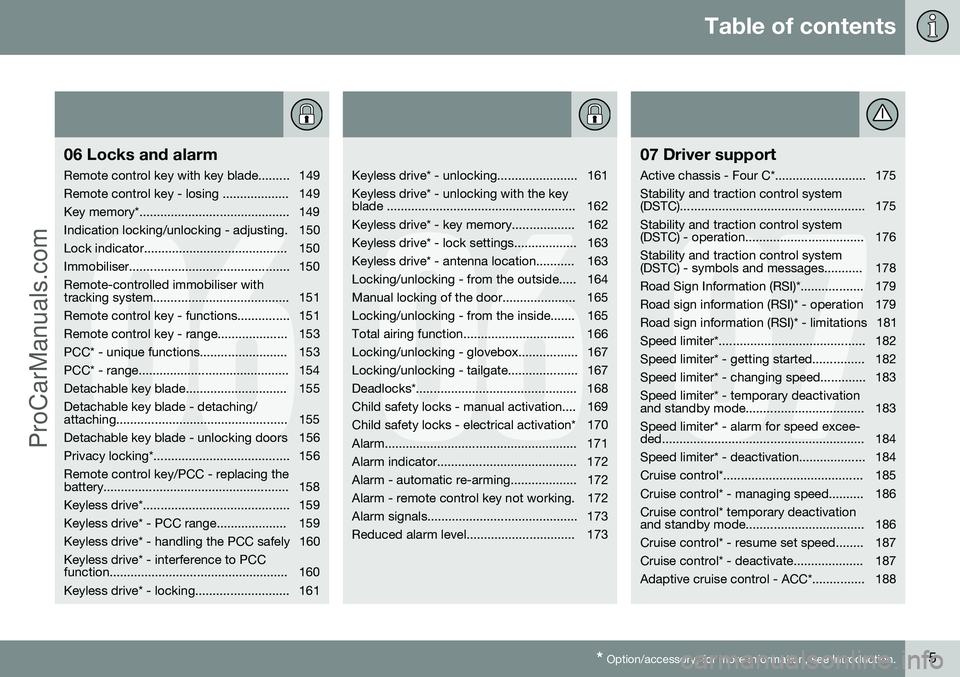
Table of contents
* Option/accessory, for more information, see Introduction.5
06
06 Locks and alarm
Remote control key with key blade......... 149
Remote control key - losing ................... 149
Key memory*........................................... 149
Indication locking/unlocking - adjusting. 150
Lock indicator......................................... 150
Immobiliser.............................................. 150Remote-controlled immobiliser with
tracking system....................................... 151
Remote control key - functions............... 151
Remote control key - range.................... 153
PCC* - unique functions......................... 153
PCC* - range........................................... 154
Detachable key blade............................. 155Detachable key blade - detaching/
attaching................................................. 155
Detachable key blade - unlocking doors 156
Privacy locking*....................................... 156Remote control key/PCC - replacing the
battery..................................................... 158
Keyless drive*.......................................... 159
Keyless drive* - PCC range.................... 159
Keyless drive* - handling the PCC safely 160Keyless drive* - interference to PCC
function................................................... 160
Keyless drive* - locking........................... 161
06
Keyless drive* - unlocking....................... 161 Keyless drive* - unlocking with the key
blade ...................................................... 162
Keyless drive* - key memory.................. 162
Keyless drive* - lock settings.................. 163
Keyless drive* - antenna location........... 163
Locking/unlocking - from the outside..... 164
Manual locking of the door..................... 165
Locking/unlocking - from the inside....... 165
Total airing function................................ 166
Locking/unlocking - glovebox................. 167
Locking/unlocking - tailgate.................... 167
Deadlocks*.............................................. 168
Child safety locks - manual activation.... 169
Child safety locks - electrical activation* 170
Alarm....................................................... 171
Alarm indicator........................................ 172
Alarm - automatic re-arming................... 172
Alarm - remote control key not working. 172
Alarm signals........................................... 173
Reduced alarm level............................... 173
07
07 Driver support
Active chassis - Four C*.......................... 175 Stability and traction control system
(DSTC)..................................................... 175 Stability and traction control system
(DSTC) - operation.................................. 176 Stability and traction control system
(DSTC) - symbols and messages........... 178
Road Sign Information (RSI)*.................. 179
Road sign information (RSI)* - operation 179
Road sign information (RSI)* - limitations 181
Speed limiter*.......................................... 182
Speed limiter* - getting started............... 182
Speed limiter* - changing speed............. 183Speed limiter* - temporary deactivation
and standby mode.................................. 183 Speed limiter* - alarm for speed excee-
ded.......................................................... 184
Speed limiter* - deactivation................... 184
Cruise control*........................................ 185
Cruise control* - managing speed.......... 186Cruise control* temporary deactivation
and standby mode.................................. 186
Cruise control* - resume set speed........ 187
Cruise control* - deactivate.................... 187
Adaptive cruise control - ACC*............... 188
ProCarManuals.co’
Page 41 of 442
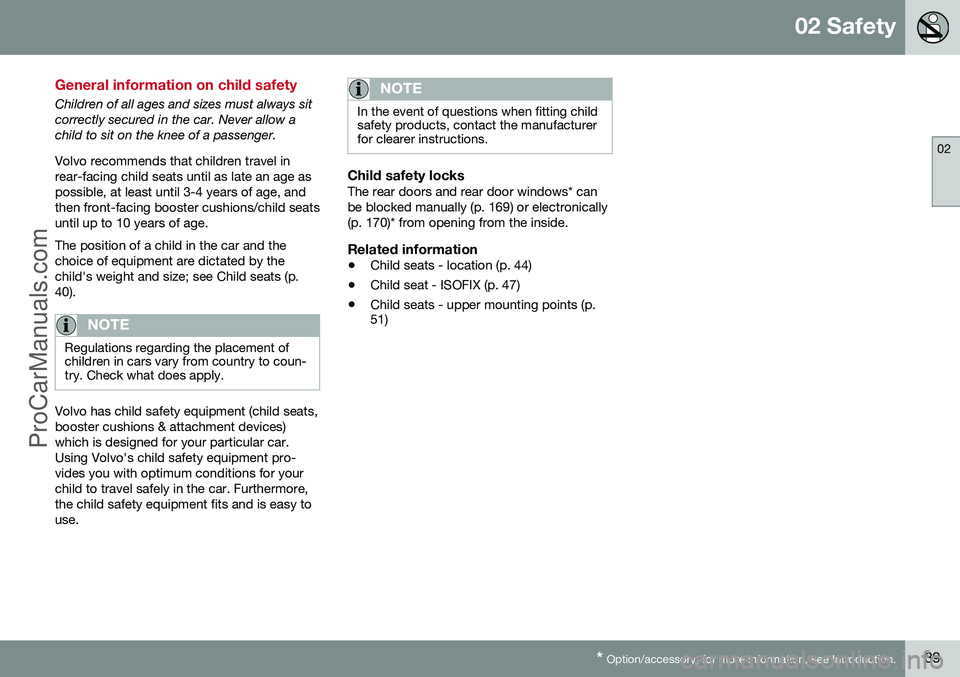
02 Safety
02
* Option/accessory, for more information, see Introduction.39
General information on child safety
Children of all ages and sizes must always sit correctly secured in the car. Never allow achild to sit on the knee of a passenger. Volvo recommends that children travel in rear-facing child seats until as late an age aspossible, at least until 3-4 years of age, andthen front-facing booster cushions/child seatsuntil up to 10 years of age. The position of a child in the car and the choice of equipment are dictated by thechild's weight and size; see Child seats (p.40).
NOTE
Regulations regarding the placement of children in cars vary from country to coun-try. Check what does apply.
Volvo has child safety equipment (child seats, booster cushions & attachment devices)which is designed for your particular car.Using Volvo's child safety equipment pro-vides you with optimum conditions for yourchild to travel safely in the car. Furthermore,the child safety equipment fits and is easy touse.
NOTE
In the event of questions when fitting child safety products, contact the manufacturerfor clearer instructions.
Child safety locksThe rear doors and rear door windows* can be blocked manually (p. 169) or electronically(p. 170)* from opening from the inside.
Related information
• Child seats - location (p. 44)
• Child seat - ISOFIX (p. 47)
• Child seats - upper mounting points (p. 51)
ProCarManuals.co’
Page 47 of 442
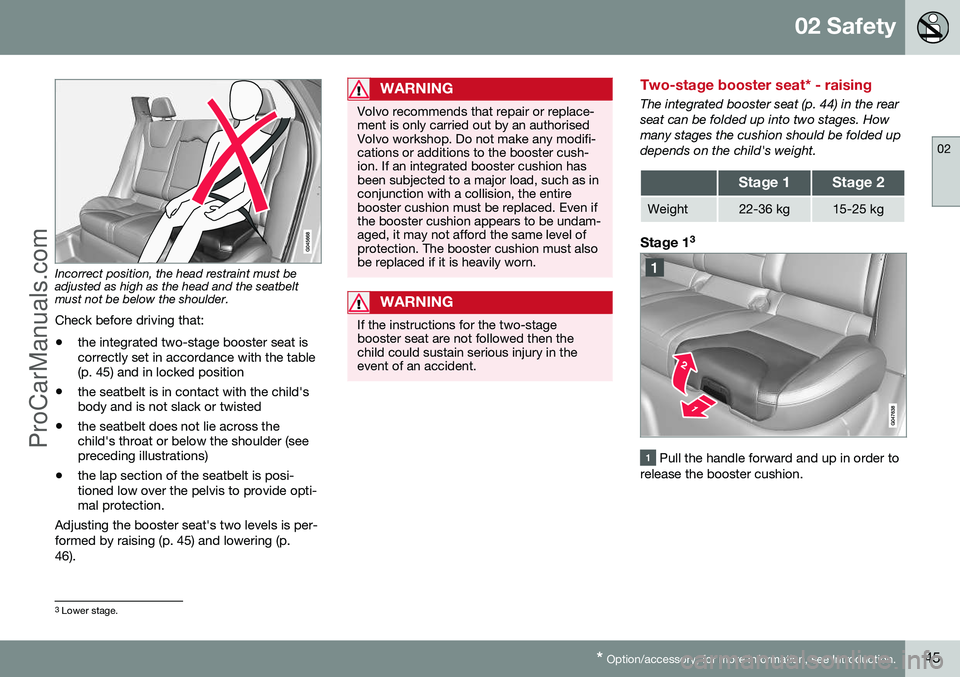
02 Safety
02
* Option/accessory, for more information, see Introduction.45
Incorrect position, the head restraint must be adjusted as high as the head and the seatbeltmust not be below the shoulder.
Check before driving that:
• the integrated two-stage booster seat is correctly set in accordance with the table(p. 45) and in locked position
• the seatbelt is in contact with the child'sbody and is not slack or twisted
• the seatbelt does not lie across thechild's throat or below the shoulder (seepreceding illustrations)
• the lap section of the seatbelt is posi-tioned low over the pelvis to provide opti-mal protection.
Adjusting the booster seat's two levels is per-
formed by raising (p. 45) and lowering (p. 46).
WARNING
Volvo recommends that repair or replace- ment is only carried out by an authorisedVolvo workshop. Do not make any modifi-cations or additions to the booster cush-ion. If an integrated booster cushion hasbeen subjected to a major load, such as inconjunction with a collision, the entirebooster cushion must be replaced. Even ifthe booster cushion appears to be undam-aged, it may not afford the same level ofprotection. The booster cushion must alsobe replaced if it is heavily worn.
WARNING
If the instructions for the two-stage booster seat are not followed then thechild could sustain serious injury in theevent of an accident.
Two-stage booster seat* - raising
The integrated booster seat (p. 44) in the rear seat can be folded up into two stages. Howmany stages the cushion should be folded updepends on the child's weight.
Stage 1Stage 2
Weight22-36 kg15-25 kg
Stage 1 3
Pull the handle forward and up in order to
release the booster cushion.
3 Lower stage.
ProCarManuals.co’
Page 49 of 442
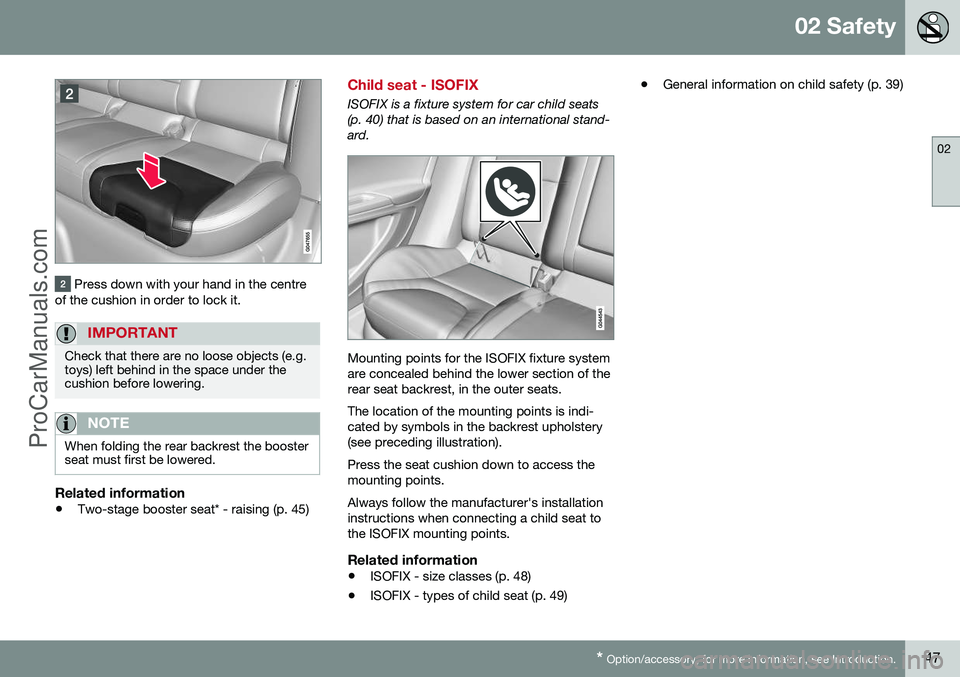
02 Safety
02
* Option/accessory, for more information, see Introduction.47
Press down with your hand in the centre
of the cushion in order to lock it.
IMPORTANT
Check that there are no loose objects (e.g. toys) left behind in the space under thecushion before lowering.
NOTE
When folding the rear backrest the booster seat must first be lowered.
Related information
• Two-stage booster seat* - raising (p. 45)
Child seat - ISOFIX
ISOFIX is a fixture system for car child seats (p. 40) that is based on an international stand-ard.
Mounting points for the ISOFIX fixture system are concealed behind the lower section of therear seat backrest, in the outer seats. The location of the mounting points is indi- cated by symbols in the backrest upholstery(see preceding illustration). Press the seat cushion down to access the mounting points. Always follow the manufacturer's installation instructions when connecting a child seat tothe ISOFIX mounting points.
Related information
•ISOFIX - size classes (p. 48)
• ISOFIX - types of child seat (p. 49) •
General information on child safety (p. 39)
ProCarManuals.co’
Page 76 of 442

03 Instruments and controls
03
74* Option/accessory, for more information, see Introduction.
Key memory* in remote control key 17
All remote control keys can be used by differ- ent drivers to store the settings for the driver's seat and door mirrors
18
.
Proceed as follows in order to store the set- tings and use the key memory:
• Adjust the seat as you want it.
• Lock the car by pressing the lock button on the remote control key that you nor-mally use. This stores the positions of theseat and door mirrors in the remote con- trol key's memory 19
.
• Unlock the car (by pressing the unlock button on the
same remote control key)
and open the driver's door. The driver'sseat and door mirrors will automaticallyadopt the positions that are stored in the remote control key's memory (if the seathas been moved since you locked thecar).
The key memory can be activated/deacti- vated in the menu system MY CAR. For a
description of the menu system, see MY CAR(p. 103).
Emergency stopIf the seat accidentally begins to move, pressone of the setting buttons for the seat ormemory buttons in order to stop the seat. Restarting to reach the seat position stored in the key memory is performed by pressing theunlock button on the remote control key. Thedriver's door must then be open.
WARNING
Risk of crushing! Make sure that children do not play with the controls. Check thatthere are no objects in front of, behind orunder the seat during adjustment. Ensurethat none of the rear seat passengers is indanger of becoming trapped.
Related information
• Remote control key - functions (p. 151)
Seats, rear
The rear seat backrest and the outer seat head restraints can be folded. The centre seathead restraint can be adjusted to suit theheight of the passenger.
Head restraint, centre seat, rear
Adjust the head restraint according to pas- senger height so that the whole of the back ofthe head is covered if possible. Slide it up asrequired. To lower the head restraint again, the button (located in the centre between the backrestand head restraint, see illustration) must bepressed in while the head restraint is presseddown carefully.
17
For key memory for Keyless function, see Keyless drive* - key memory (p. 162).
18 Only if the car is equipped with power seat with memory and retractable power door mirrors.
19 This setting does not affect settings that have been stored in the power seat's memory function.
ProCarManuals.co’
Page 94 of 442
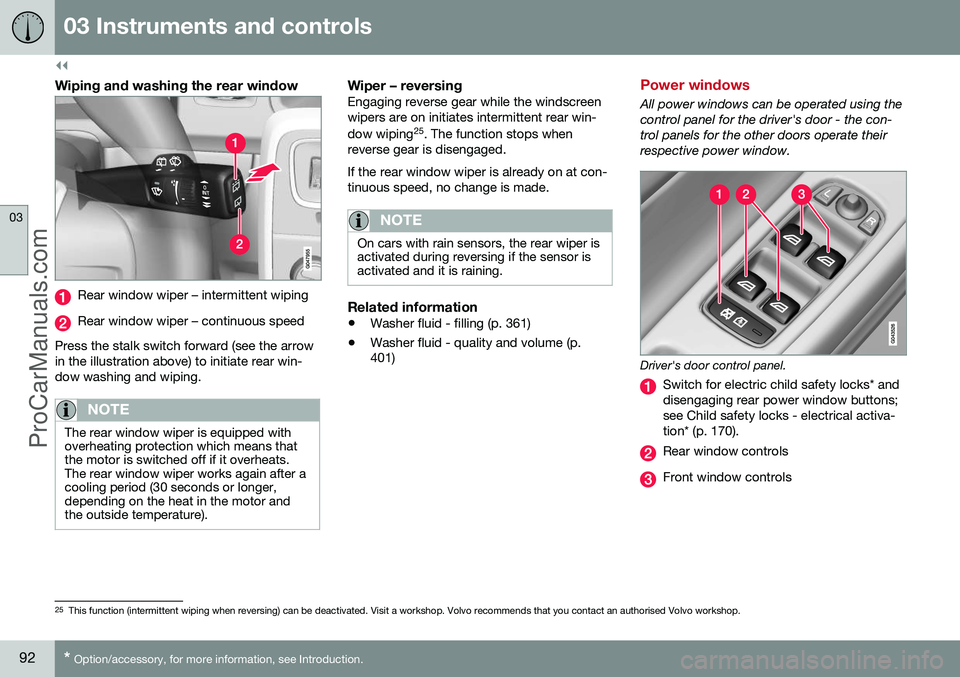
||
03 Instruments and controls
03
92* Option/accessory, for more information, see Introduction.
Wiping and washing the rear window
Rear window wiper – intermittent wiping
Rear window wiper – continuous speed
Press the stalk switch forward (see the arrow in the illustration above) to initiate rear win-dow washing and wiping.
NOTE
The rear window wiper is equipped with overheating protection which means thatthe motor is switched off if it overheats.The rear window wiper works again after acooling period (30 seconds or longer,depending on the heat in the motor andthe outside temperature).
Wiper – reversingEngaging reverse gear while the windscreen wipers are on initiates intermittent rear win- dow wiping 25
. The function stops when
reverse gear is disengaged. If the rear window wiper is already on at con- tinuous speed, no change is made.
NOTE
On cars with rain sensors, the rear wiper is activated during reversing if the sensor isactivated and it is raining.
Related information
• Washer fluid - filling (p. 361)
• Washer fluid - quality and volume (p. 401)
Power windows
All power windows can be operated using the control panel for the driver's door - the con-trol panels for the other doors operate theirrespective power window.
Driver's door control panel.
Switch for electric child safety locks* and disengaging rear power window buttons;see Child safety locks - electrical activa-tion* (p. 170).
Rear window controls
Front window controls
25
This function (intermittent wiping when reversing) can be deactivated. Visit a workshop. Volvo recommends that you contact an authorised Volvo workshop.
ProCarManuals.co’
Page 95 of 442
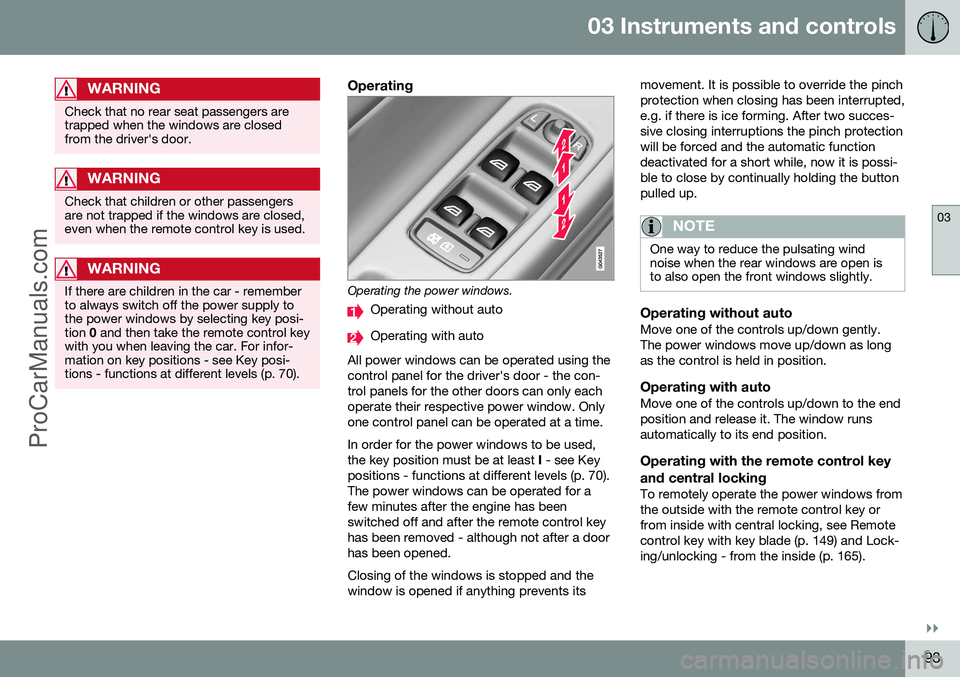
03 Instruments and controls
03
}}
93
WARNING
Check that no rear seat passengers are trapped when the windows are closedfrom the driver's door.
WARNING
Check that children or other passengers are not trapped if the windows are closed,even when the remote control key is used.
WARNING
If there are children in the car - remember to always switch off the power supply tothe power windows by selecting key posi-tion 0 and then take the remote control key
with you when leaving the car. For infor-mation on key positions - see Key posi-tions - functions at different levels (p. 70).
Operating
Operating the power windows.
Operating without auto
Operating with auto
All power windows can be operated using the control panel for the driver's door - the con-trol panels for the other doors can only eachoperate their respective power window. Onlyone control panel can be operated at a time. In order for the power windows to be used, the key position must be at least I - see Key
positions - functions at different levels (p. 70).The power windows can be operated for afew minutes after the engine has beenswitched off and after the remote control keyhas been removed - although not after a doorhas been opened. Closing of the windows is stopped and the window is opened if anything prevents its movement. It is possible to override the pinchprotection when closing has been interrupted,e.g. if there is ice forming. After two succes-sive closing interruptions the pinch protectionwill be forced and the automatic functiondeactivated for a short while, now it is possi-ble to close by continually holding the buttonpulled up.
NOTE
One way to reduce the pulsating wind noise when the rear windows are open isto also open the front windows slightly.
Operating without autoMove one of the controls up/down gently. The power windows move up/down as longas the control is held in position.
Operating with autoMove one of the controls up/down to the endposition and release it. The window runsautomatically to its end position.
Operating with the remote control key and central locking
To remotely operate the power windows from the outside with the remote control key orfrom inside with central locking, see Remotecontrol key with key blade (p. 149) and Lock-ing/unlocking - from the inside (p. 165).
ProCarManuals.co’
Page 101 of 442

03 Instruments and controls
03
}}
99
OpeningFor maximum sunroof opening, move the control back to the position for automaticopening and release. Open manually by pulling the control back- wards to the point of resistance for manualopening. The sunroof moves to maximumopen position as long as the button is keptdepressed.
ClosingClose manually by pushing the control for-wards to the point of resistance for manualclosing. The sunroof moves to closed posi-tion as long as the button is kept depressed.
WARNING
Risk of crushing when the sunroof is closed. The sunroof's pinch-protectionfunction only operates during automaticclosing, not manual.
Close automatically by pressing the control to the position for automatic closing and thenrelease it. The power supply to the sunroof is switched off by selecting key position 0 and removing
the remote control key from the ignitionswitch.
WARNING
If there are children in the car: Remember to always switch off the power supply to the sunroof by selecting keyposition 0 and then take the remote con-
trol key with you when leaving the car. Forinformation on key positions - see Keypositions - functions at different levels (p.70).
Vertical opening
G028900
Vertical opening, raised at the rear edge.
Open by pressing the rear edge of the control upward.
Close by pulling the rear edge of the con- trol down.
Closing using the remote control key or central locking button
G021345
One long press on the lock button closes the sunroof and all the windows, see Remotecontrol key - functions (p. 151) and Locking/unlocking - from the inside (p. 165). Thedoors and the tailgate are locked. To interruptclosing, press the lock button again.
WARNING
If the sunroof is closed with the remote control key, check that no one risks beingtrapped.
SunscreenThe sunroof features a manual, sliding interior sunscreen. The sunscreen slides back auto-matically when the sunroof is opened. Gripthe handle and slide the screen forward toclose it.
ProCarManuals.co’
Page 151 of 442

06 Locks and alarm
06
* Option/accessory, for more information, see Introduction.149
Remote control key with key blade
The remote control key is used to start the car and for locking and unlocking. It contains adetachable key blade (p. 155) made of metal.The visible section is available in two versionsso that it is possible to distinguish betweenthe remote control keys. The car is supplied with 2 remote control keys or PCCs* (Personal Car Communicator). Additional remote control keys can be ordered - up to 6 can be programmed andused for the same car.
WARNING
If there are children in the car: Remember to switch off the supply to the power windows and sunroof by removingthe remote control key if the driver leavesthe car.
Remote control key with PCC (p. 153) has increased functionality compared with theremote control key, see PCC* - unique func-tions (p. 153).
Related information
• Remote control key - functions (p. 151)
Remote control key - losing
If you lose a remote control key then a new one can be ordered at a workshop - anauthorised Volvo workshop is recommended. The remaining remote control keys must be taken to the Volvo workshop. The code of themissing remote control key must be erasedfrom the system as a theft prevention meas-ure. The current number of keys registered tothe car can be checked in the menu systemMY CAR
. For a description of the menu sys-
tem, see MY CAR (p. 103).
Related information
• Remote control key - functions (p. 151)
Key memory*
The key memory in the remote control key (p. 149) means that certain settings in the car canbe individually adapted for different people. The key memory function is available in com- bination with power seat and power rearviewand door mirrors. Settings for door mirrors,driver's seat and steering force can be savedin the key memory.
Key memory – door mirrors and driver's
seat
The settings are automatically connected toeach respective remote control key, see Keymemory* in remote control key (p. 74) andAdjustable steering force* (p. 257). Afterlocking with the remote control key the set-ting of the combined instrument panel'stheme is also saved in the key, see MY CAR(p. 103). The function can be activated/deactivated in the menu system MY CAR. For a description
of the menu system, see MY CAR (p. 103). For cars with the Keyless drive function, see Keyless drive* (p. 159).
ProCarManuals.co’
Page 157 of 442

06 Locks and alarm
06
* Option/accessory, for more information, see Introduction.155
Detachable key blade
A remote control key (p. 149) contains a detachable key blade of metal with whichsome functions can be activated and someoperations carried out. The key blade's unique code is provided by authorised Volvo workshops, which are rec-ommended when ordering new key blades.
Key blade functionsUsing the remote control key's detachablekey blade:
• the left-hand front door can be opened manually if central locking cannot be acti-vated with the remote control key, seeDetachable key blade - unlocking doors(p. 156).
• the rear doors' mechanical child safetylocks can be activated/deactivated (p.169).
• the right-hand front door and the reardoors can be locked manually (p. 165),e.g. in the event of power failure.
• access to the glovebox and cargo area(privacy locking (p. 156)*) can beblocked.
• the airbag for front passenger seat(PACOS*) can be activated/deactivated(p. 30).
Related information
•Remote control key - functions (p. 151)
• Remote control key with key blade (p.149)
Detachable key blade - detaching/ attaching
Detaching/attaching the detachable key blade (p. 155) is carried out as follows:
Removing the key blade
Slide the spring-loaded catch to the side.
At the same time pull the key blade straight out backwards.
Attaching the key bladeCarefully refit the key blade into its location inthe remote control key (p. 149).
1. Hold the remote control key with the slot
pointed up and lower the key blade into its slot.
2. Lightly press the key blade. You should hear a "click" when the key blade islocked in.
ProCarManuals.co’